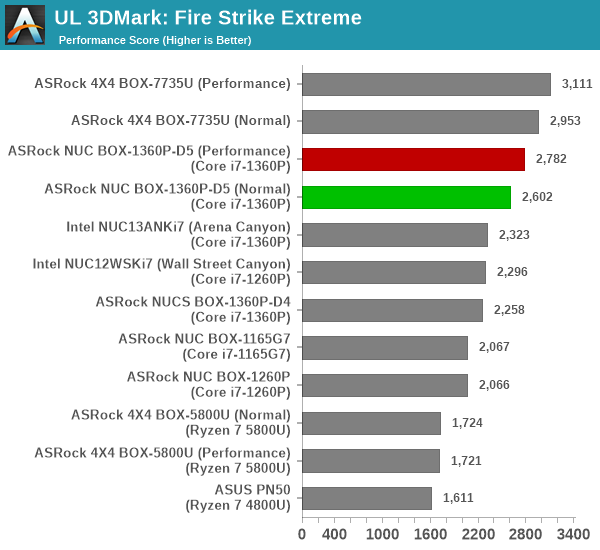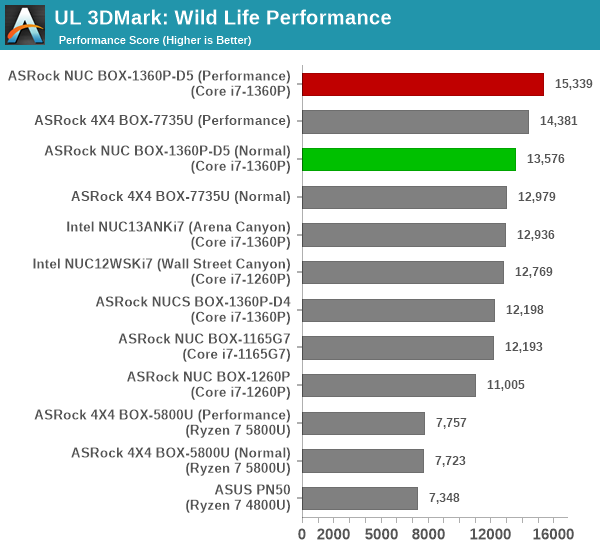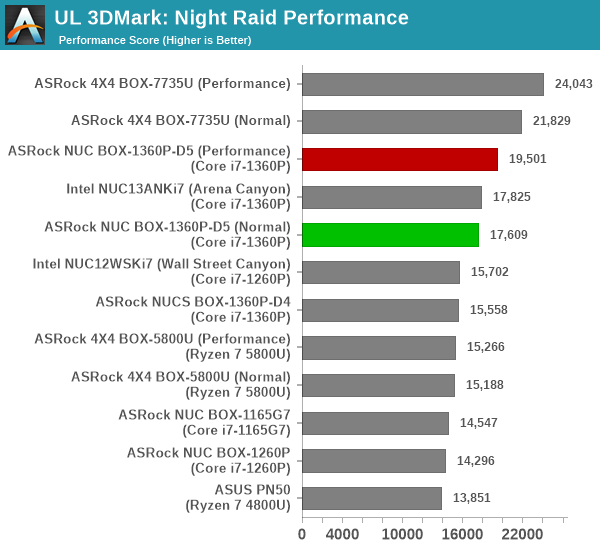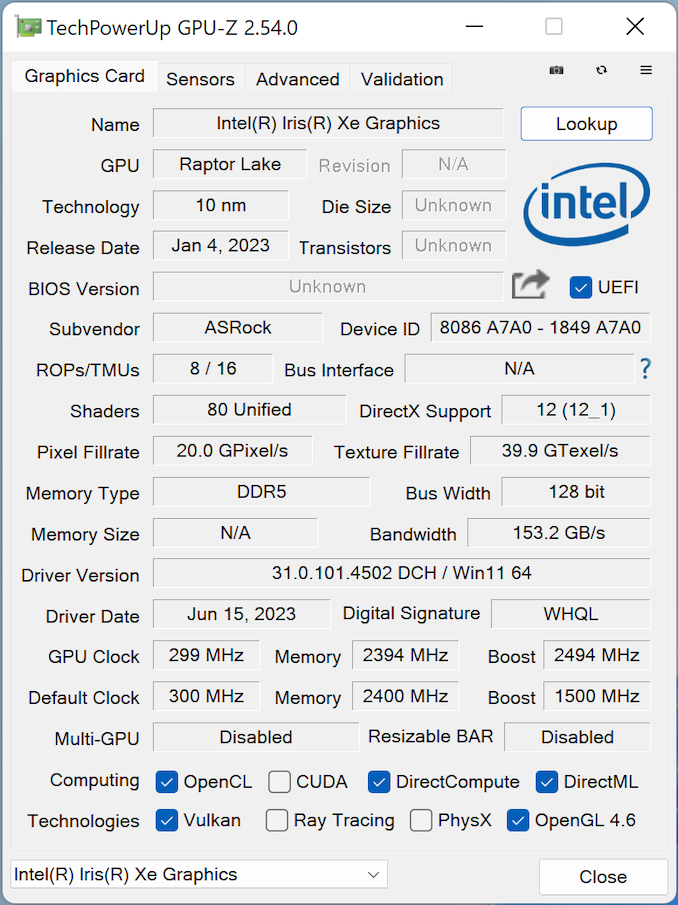ASRock Industrial NUC BOX-1360P/D5 Review: Raptor Lake-P on the Leading Edge
by Ganesh T S on July 18, 2023 10:30 AM EST- Posted in
- Systems
- Intel
- UCFF
- Mini-PC
- ASRock Industrial
- Raptor Lake-P
GPU Performance: Synthetic Benchmarks
Intel did not make significant changes in the integrated GPU when moving from Alder Lake to Raptor Lake. Process maturity has allowed it to clock the iGPU a bit higher, but the number of EUs remains the same as in the previous generation. GPU performance evaluation typically involved gaming workloads, and for select PCs, GPU compute. Prior to that, we wanted to take a look at the capabilities of the iGPU in the Core i7-1360P.
The Intel Iris Xe Graphics in the Core i7-1360P handily outperforms the iGPU in the Ryzen 5000U. However, we saw in the review of the 4X4 BOX-7735U that RDNA2 managed to wrest back the crown for AMD in the iGPU space. The evaluation of GPU workloads in the NUC BOX-1360P/D5 and comparison against previous results can allow us to check whether DDR5 can provide some extra performance benefits.
GFXBench
The DirectX 12-based GFXBench tests from Kishonti are cross-platform, and available all the way down to smartphones. As such, they are not very taxing for discrete GPUs and modern integrated GPUs. We processed the offscreen versions of the 'Aztec Ruins' benchmark.


At lower resolutions, the higher power budget is a boon for the NUC BOX-1360P/D5. Even the normal mode outperforms the best possible numbers from the 7735U. However, a resolution increase results in the RDNA2 iGPU reclaiming the title.
UL 3DMark
Four different workload sets were processed in 3DMark - Fire Strike, Time Spy, Night Raid, and Wild Life.
3DMark Fire Strike
The Fire Strike benchmark has three workloads. The base version is meant for high-performance gaming PCs. It uses DirectX 11 (feature level 11) to render frames at 1920 x 1080. The Extreme version targets 1440p gaming requirements, while the Ultra version targets 4K gaming system, and renders at 3840 x 2160. The graph below presents the overall score for the Fire Strike Extreme and Fire Strike Ultra benchmark across all the systems that are being compared.
| UL 3DMark - Fire Strike Workloads | |||

The GFXBench results had already revealed that the RDNA2 iGPU in the 7735U outperforms the Iris Xe iGPU in the Core i7-1360P. So, it is no surprise that the 7735U takes the top two spots in both versions of the Fire Strike benchmark.
3DMark Time Spy
The Time Spy workload has two levels with different complexities. Both use DirectX 12 (feature level 11). However, the plain version targets high-performance gaming PCs with a 2560 x 1440 render resolution, while the Extreme version renders at 3840 x 2160 resolution. The graphs below present both numbers for all the systems that are being compared in this review.
| UL 3DMark - Time Spy Workloads | |||

The usage of 1440p and 2160p resolutions again mean that the NUC BOX-1360P/D5 has to put up with the third place. There is a bit of an advantage for it over the DDR4-based Arena Canyon NUC and the NUCS BOX-1360P/D4 systems.
3DMark Wild Life
The Wild Life workload was initially introduced as a cross-platform GPU benchmark in 2020. It renders at a 2560 x 1440 resolution using Vulkan 1.1 APIs on Windows. It is a relatively short-running test, reflective of mobile GPU usage. In mid-2021, UL released the Wild Life Extreme workload that was a more demanding version that renders at 3840 x 2160 and runs for a much longer duration reflective of typical desktop gaming usage.
| UL 3DMark - Wild Life Workloads | |||

The Wild Life workloads finally see the NUC BOX-1360P/D5's 40W PL1 avatar successfully overtage the 7735U's best performance mode.
3DMark Night Raid
The Night Raid workload is a DirectX 12 benchmark test. It is less demanding than Time Spy, and is optimized for integrated graphics. The graph below presents the overall score in this workload for different system configurations.

This workload sees a repeat of the Time Spy rankings, with the RDNA2 iGPU being miles ahead of the Iris Xe iGPU in the Core i7-1360P-based systems.











21 Comments
View All Comments
ganeshts - Wednesday, July 19, 2023 - link
Any links to such a 'NUC' ?I do have a Phoenix-based GTR7 from Beelink here in my testbed, but driver issues are preventing it from completing our benchmark suite. I am waiting for a new driver release from AMD.
lemurbutton - Friday, July 21, 2023 - link
And any M2 Mac Mini would destroy any Zen4 NUC.TheinsanegamerN - Monday, July 24, 2023 - link
Until you have to run something not in the MAC ecosystem. OOPS!PeachNCream - Friday, July 21, 2023 - link
I don't think destruction is quite the right to articulate your apparent thoughts. Perhaps "result in higher scores on benchmarks" or maybe "complete compute workloads sooner" would fit better in this case. Computer nerds appear to be rather detached from reality when expressing thoughts which gives all of them a bad reputation among the better positioned and more intelligent normal population.Samus - Saturday, July 22, 2023 - link
The problem with AMD enterprise and industrial products has always been management adoption. Intel has IT depts hooked on vPro, iME, AMT, etc.nicolaim - Wednesday, July 19, 2023 - link
It's 2023. Only two USB-C ports, none on the back.Samus - Thursday, July 20, 2023 - link
That was my gripe. Replace the HDMI and DP ports with two TB4-compliant USB-C ports on the rear would be the minimum modification for such an 'industrial' appliance. Seriously, why do you have to plug something into the front to use Thunderbolt?PeachNCream - Thursday, July 20, 2023 - link
Probably because nobody uses or cares about Thunderbolt. Sure it has that usual small, insane rabid fanbase that any obscure computer standard had in the past, but outside of the inevitable idiots that inflate its utility, no one cares and no one profits from it.abufrejoval - Monday, July 24, 2023 - link
That's a bit harsh.Yes, using TB to its full potential is somewhat expensive but given a choice, I'll always opt for the TB variant over pure USB, if only for 10Gbit Ethernet.
Front vs. back: I guess they have done their studies on how people use TB and unfortunately habits vary between people.
Most of my dual TB systems have one TB in the front, the other in the back and that works pretty well for me. The 10GBase-T NIC goes into the back port and the front port is open to anything transient, which could be just some USB media (these native SATA 10Gbit USB sticks are hard to beat via anything native TB), a temporary display (Alt-DP handy there) and in theory to things like TB networking, which is typically transient.
The older systems just have a single TB and expect a hub connected on the back, which seems sensible.
Two in the front and two in the back would be better still, even if you couldn't use all four at full speed for lack of PCIe lanes or a cheap enough switch.
Yet again, when your NUC is stuck to the back of a display, who cares what's front or back, because it's all behind the screen anyway and it's only people like me, wo use clusters of these NUCs as µ-servers in a "tiny-rack" who get bothered by the orientation of those ports.
Changing port orientation in a NUC means a mainboard redesign and few would want to pay for that. So I guess their asked their volume customers and this is what those came up with.
Very few vendors want to aggravate the customers.
sjkpublic@gmail.com - Thursday, July 20, 2023 - link
Performance comparison says it all. 1360P DOA. 7735U $100-200 cheaper for ASROCK. Even cheaper if you look at other companies.